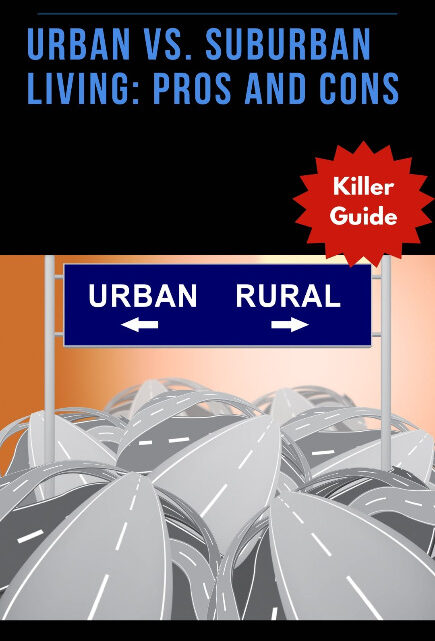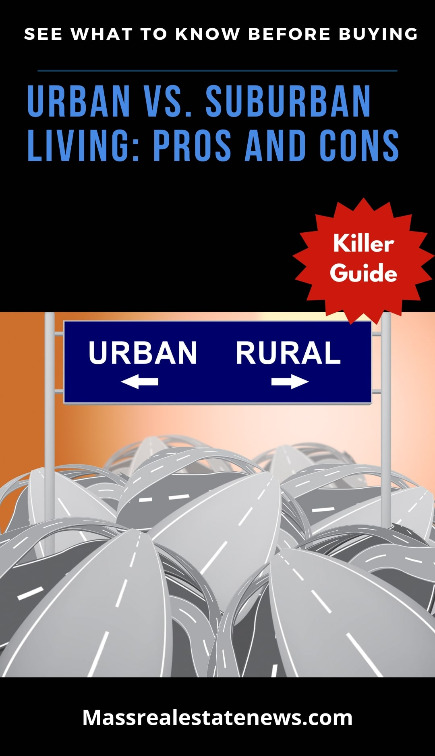Urban and suburban living in Massachusetts offers distinct experiences. Residents enjoy convenient access to amenities, cultural diversity, and vibrant city life in urban areas.
Suburban living, on the other hand, brings peace, family-friendly environments, and quality schools. Both options have their advantages and considerations.
We will explore the characteristics, pros and cons, real estate trends, and factors to consider when choosing between urban and suburban living in Massachusetts. The difference between living in a city vs. a suburb can be substantial. Let’s delve into this fascinating comparison.
Understanding Urban and Suburban Living in Massachusetts
Massachusetts offers diverse living options, with urban and suburban areas providing distinct lifestyles.
Understanding the characteristics of both living environments can help individuals make informed decisions about where to reside in the state.
Definition and Characteristics of Urban Areas
Massachusetts’s densely populated nature and vibrant city life define urban areas. These regions, such as Boston and its surrounding neighborhoods, feature a bustling atmosphere and a wide range of amenities and services. The key characteristics of urban areas include the following:
- Density: Urban areas have high population density, with numerous residential and commercial buildings packed into a limited space.
- Amenities and Services: Cities offer an extensive array of amenities, including shopping centers, restaurants, entertainment venues, cultural attractions, and healthcare facilities.
- Diversity: Urban areas tend to be culturally diverse, housing people from various backgrounds and ethnicities, leading to a rich multicultural environment.
- Public Transportation: Cities usually have well-developed public transportation systems, making it easier to navigate the area without relying heavily on private vehicles.
- Dynamic Lifestyle: Urban living offers a fast-paced and active lifestyle, with numerous events, social activities, and career opportunities.
Definition and Characteristics of Suburban Areas
Suburban areas in Massachusetts provide a more laid-back and family-oriented living experience. These regions are typically located outside major cities and offer a combination of residential, commercial, and green spaces.
The critical characteristics of suburban areas include the following:
- Spaciousness: Suburbs offer more spaciousness than urban areas, with larger homes, yards, and open spaces for residents to enjoy.
- Peaceful Environment: Suburban living is associated with tranquility and community. The neighborhoods are often quieter and provide a more relaxed atmosphere.
- Schools and Education: Suburban areas are known for their quality school systems, providing families with excellent educational opportunities for children.
- Family-Friendly Amenities: Suburbs usually have family-friendly amenities such as parks, playgrounds, and recreational areas, making them ideal for raising children.
- Car Dependence: Unlike urban areas, suburban living relies more on private vehicles, as public transportation options may be limited.
Understanding the defining characteristics of urban and suburban areas in Massachusetts is crucial for individuals seeking the right setting to call home.
Examining the pros and cons of both options can help individuals make an informed choice that aligns with their lifestyle, preferences, and priorities.
Pros and Cons of Urban Living in Massachusetts
Living in urban areas in Massachusetts offers many advantages and considerations for residents.
Let’s explore some of the critical aspects:
Access to Amenities and Services in Urban Areas
The urban landscape of Massachusetts provides easy access to a wide range of amenities and services. Urban areas offer a vibrant and bustling environment, from restaurants, cafes, and shopping centers to recreational facilities, cultural institutions, and entertainment venues.
Whether you’re looking for a trendy restaurant, a concert, or a museum visit, urban living provides numerous choices within proximity.
Diversity and Cultural Opportunities in Cities
Massachusetts’ urban centers are known for their rich diversity and cultural offerings. The cities are melting pots, attracting people from different backgrounds, ethnicities, and cultures. This diversity creates a vibrant tapestry of experiences, celebrations, and communities.
Urban living immerses you in a multicultural environment, fostering a greater appreciation for different perspectives, cuisines, languages, and traditions.
Cost of Living and Housing in Urban Areas
While urban areas in Massachusetts offer many amenities and cultural opportunities, the cost of living and housing tends to be higher than suburban areas. The demand for prime urban real estate and the limited availability drive up prices. The cost of living in Boston can be prohibitive.
Renting or buying a home in the city often requires a more substantial financial commitment. However, it’s essential to weigh the cost against the convenience, accessibility, and overall urban lifestyle that aligns with your personal preferences and career prospects.
- Ease of access to various amenities, including restaurants, shopping centers, and entertainment venues.
- A vibrant multicultural environment with a rich tapestry of experiences, celebrations, and communities.
- Higher cost of living and housing than in suburban areas due to the demand and limited availability of prime urban real estate.
Living in an urban area in Massachusetts offers unparalleled access to amenities, a diverse cultural environment, and exciting opportunities. However, it’s essential to consider the higher cost of living and housing when deciding on the right fit for your lifestyle and budget.
Now, let’s explore the pros and cons of suburban living in Massachusetts.
Pros and Cons of Suburban Living in Massachusetts
Suburban living in Massachusetts offers a variety of advantages and considerations for individuals and families seeking a peaceful and family-friendly environment, quality schools, and convenient commuting options.
Peaceful and Family-Friendly Environment in the Suburbs
One of the significant highlights of suburban living in Massachusetts is the tranquil and family-friendly environment it provides. Suburban neighborhoods often feature tree-lined streets, spacious yards, and a sense of community. These areas offer a reprieve from the hustle and bustle of urban life, providing residents with a more relaxed and peaceful atmosphere.
Safety is often prioritized in suburban areas, making it an attractive choice for families and individuals seeking a secure environment. The low crime rates and closely-knit communities foster a sense of belonging, making it easier to develop strong relationships with neighbors and participate in community events.
Quality of Schools and Education Options
Regarding education, suburban living in Massachusetts often offers exceptional school districts and education options. Many suburbs pride themselves on having top-notch public and private schools with lower student-to-teacher ratios and dedicated educators.
The quality of schools in suburban areas can contribute to a higher standard of education and opportunities for students. Parents can feel confident that their children receive quality instruction and access to various extracurricular activities.
Commuting and Transportation in Suburban Areas
While suburban living may involve longer commute times compared to urban areas, Massachusetts has tried to enhance transportation options in suburban regions. Many suburbs offer reliable public transportation systems, such as commuter rail lines and bus services, allowing residents to travel to nearby cities for work or leisure activities.
Additionally, suburban areas often have less congested roads than cities, making commuting more comfortable and less stressful. Residents can enjoy a smoother driving experience and, in some cases, shorter travel times within the suburbs.
- Overall, suburban living in Massachusetts provides a peaceful and family-friendly environment, exceptional schools, and improved commuting options.
- Residents can enjoy a sense of security, develop strong community ties, and experience a greater connection with nature.
- Furthermore, the quality of education in suburban areas can give children a solid foundation for future success.
- While longer commutes may be a consideration, the availability of reliable public transportation and less congested roads help alleviate transportation concerns.
Consider your preferences and priorities when deciding between urban and suburban living in Massachusetts. Factoring in lifestyle, education, and commuting can help you make an informed decision that aligns with your needs and enhances your overall quality of life.
Lifestyle and Community in Urban and Suburban Massachusetts
When considering urban and suburban living in Massachusetts, exploring each option’s unique lifestyle and sense of community is essential. From social interactions to recreational opportunities and cultural offerings, here are some key aspects to consider:
Social Interactions and Community Engagement
You’ll find a bustling and vibrant social scene in urban areas, with diverse communities and a rich tapestry of cultural backgrounds. The city fosters opportunities to connect with people from various walks of life through events, festivals, and neighborhood gatherings.
Whether exploring local art galleries, joining community organizations, or attending networking events, urban living provides social interactions and community engagement on a larger scale.
A more intimate and tight-knit community atmosphere tends to prevail in suburban areas. Neighbors often know each other by name, and there’s a sense of belonging and camaraderie.
Community events, such as block parties and farmers’ markets, play a central role in fostering connections among residents. Suburban living offers the opportunity to form more profound and long-lasting relationships with neighbors, creating a solid support system and a sense of belonging.
Recreation and Outdoor Spaces
Urban living in Massachusetts provides an abundance of recreational options. Parks, green spaces, and public gardens offer sanctuaries for residents to relax, exercise, and enjoy nature amidst the bustling cityscape.
From jogging along the Charles River Esplanade in Boston to exploring the Boston Common, the urban landscape offers diverse outdoor spaces for recreational activities.
Suburban living, on the other hand, boasts extensive access to recreational opportunities. Larger yards, open spaces, and closer proximity to nature often characterize suburbs. Residents can enjoy hiking, biking, and picnicking in local parks, forests, and nature reserves.
Suburban communities prioritize family-friendly amenities such as playgrounds, swimming pools, and sports facilities, providing ample leisure and outdoor recreation opportunities.
Cultural and Entertainment Offerings
Urban living in Massachusetts provides unrivaled access to various cultural and entertainment offerings. The city’s vibrant cultural scene offers something for everyone, from museums, theaters, and art galleries to music festivals, concerts, and live performances.
It’s easy to immerse yourself in the diverse arts and cultural experiences that urban areas like Boston and Cambridge offer.
In suburban areas, cultural and entertainment offerings may be more limited but still present. Local theaters, community art centers, and seasonal events provide a sense of cultural enrichment and enjoyment.
Suburban living also allows for a quieter pace of life, offering opportunities for relaxation and a retreat from the hustle and bustle of urban areas.
- Urban living in Massachusetts offers a bustling social scene with diverse communities and cultural interactions.
- Suburban living fosters a strong sense of community, with close-knit relationships and neighborhood events.
- Urban areas provide an abundance of parks and green spaces for recreational activities.
- Suburban living offers larger yards, open spaces, and closer proximity to nature.
- Urban areas boast various cultural and entertainment offerings, from museums to live performances.
- Suburban areas may have more limited but still present opportunities for cultural enrichment and entertainment.
Real Estate and Housing Options in Massachusetts
Regarding real estate and housing options, Massachusetts offers diverse urban and suburban living choices. Understanding the trends and market conditions in both areas is essential to make an informed decision.
Let’s explore the current landscape of real estate in Massachusetts.
Trends and Market Conditions in Urban Areas
Urban areas in Massachusetts, such as Boston and its surrounding neighborhoods, are known for their high demand and competitive real estate market. The limited supply of properties in these areas often drives prices up and creates a seller’s market.
The urban housing market in Massachusetts typically includes a mix of apartments, condominiums, and townhouses. These properties are often coveted for their proximity to amenities, employment opportunities, and vibrant city life. The demand for urban living continues to be driven by young professionals, students, and individuals seeking the convenience and excitement of city living.
While the prices of urban properties can be relatively higher than suburban areas, they also tend to be suitable long-term investments due to their strong appreciation rates.
Trends and Market Conditions in Suburban Areas
Suburban areas in Massachusetts have experienced a surge in demand, especially in recent years. These areas offer a more tranquil and family-friendly lifestyle, spacious homes, and a sense of community. Suburbs within commuting distance to major urban centers like Boston have mainly seen increased interest from homebuyers.
For example, my hometown of Hopkinton, Massachusetts, is seen as a destination for many home buyers. It is a trendy community due to exceptional schools and easy access to major routes.
The crossroads of New England are in Hopkinton with Route 495 and The Mass Pike.
Suburban housing options in Massachusetts typically consist of single-family homes, townhomes, and some condominium developments. The market conditions in suburban areas often vary, with some towns experiencing competitive bidding wars, especially in highly desirable school districts or areas with significant amenities.
The cost of building a house in suburbs close to Boston has skyrocketed over the last few years.
Finding affordable new construction is more challenging than it has ever been.
As demand rises, it is crucial to act quickly in the suburban market and work with a knowledgeable real estate agent who can guide you through the buying process.
Affordability and Availability of Homes
Affordability and availability of homes differ between urban and suburban areas in Massachusetts. While urban areas may have higher property prices, there are still opportunities to find affordable housing options, especially in up-and-coming neighborhoods or areas undergoing revitalization.
In contrast, suburban areas often offer more affordable housing options, particularly for buyers looking for more space and a quieter lifestyle. However, it’s worth noting that some highly sought-after suburban towns, known for their excellent schools or proximity to amenities, may have higher price tags.
Availability of homes also varies depending on the location and demand. In tighter suburban markets, acting quickly and preparing to make competitive offers to secure a property might be necessary.
Factors to Consider When Choosing Between Urban and Suburban Living
Choosing between urban and suburban living in Massachusetts requires careful consideration of various factors. Each option offers a unique lifestyle, and understanding your preferences and needs is crucial in making an informed decision.
Personal Preferences and Lifestyle Considerations
Consider your personal preferences and lifestyle when deciding between urban and suburban living. Urban areas offer a bustling environment with access to cultural events, entertainment, and diverse dining options.
Suburban areas, on the other hand, provide a quieter atmosphere, more space, and a sense of community. Reflect on whether you prioritize convenience, social interactions, or peace and tranquility daily.
Additionally, think about your recreational activities and hobbies. Urban areas tend to have more recreational facilities, parks, and nightlife options, while suburban areas often offer more opportunities for outdoor activities, such as hiking, biking, and gardening.
Career Opportunities and Job Markets
Consider the career opportunities and job markets when deciding between urban and suburban living. Urban areas, especially cities like Boston, tend to have a broader range of industries, companies, and job opportunities.
Urban areas may offer more options and higher salaries if you work in a specific field, such as technology, finance, or healthcare. However, suburban areas often provide a better work-life balance, with shorter commutes and a less stressful pace of life.
Transit Accessibility and Commute Time
Accessibility and commute time are important factors to consider. Urban areas usually have better access to public transportation, making it easier to navigate the city and reducing the reliance on cars. This can be beneficial if you prefer to avoid driving or are concerned about environmental sustainability.
However, suburban areas may have limited public transportation options, making car ownership necessary for daily commuting. Evaluate your tolerance for commuting time and the convenience of transportation options available in each area.
Final Thoughts
Ultimately, deciding to live in an urban or suburban area in Massachusetts depends on your priorities, lifestyle preferences, career goals, and transportation needs. Contemplate these factors to choose the best living environment for your desired quality of life.










No Comment